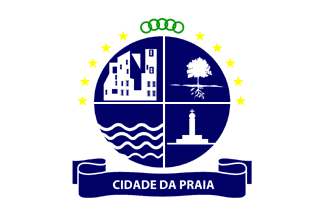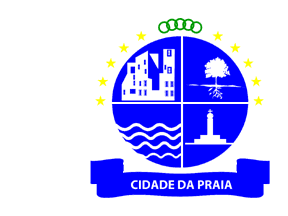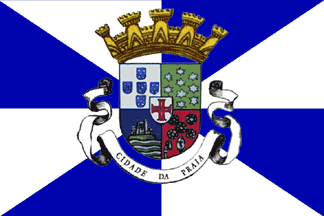 image by António Martins, 17 April 2016
image by António Martins, 17 April 2016
FOTW beschäftigt sich mit der Wissenschaft der Vexillologie (Flaggenkunde).
Alle auf dieser Website dargebotenen Abbildungen dienen ausschließlich der Informationsvermittlung im Sinne der Flaggenkunde.
Wir distanziert uns ausdrücklich von allen hierauf dargestellten Symbolen verfassungsfeindlicher Organisationen.
Last modified: 2020-12-26 by rob raeside
Keywords: praia | disc (blue) | tree (white) | house | pillory | waves: 4 | coat of arms: quartered | coat of arms: inescutcheon (cross: red) | gyronny: 8 (blue white) | mural crown (golden) | salt | crozier (white) |
Links: FOTW homepage |
search |
disclaimer and copyright |
write us |
mirrors
 image by António Martins, 17 April 2016
image by António Martins, 17 April 2016
See also:
External links:
A white flag with the logo on it (source:
official website). I have found, over
the past two years, several versions [of the flag
and the emblem].
Jens Pattke, 13 May 2012
Concerning the adoption date, the earliest proof of its existence I
found so far is
this
photo taken on 2008.08.27. The flag, sadly limp for lack of wind,
is hoisted on the balcony of the City Hall, to the left of the
national flag, and shows the white background and a
piece of the scroll — visible as very pale blue: This is either
due to sun bleaching (which would date this flag from early 2008 or
earlier) or to the use of much lighter colors back then.
António Martins, 21 December 2016
 image by António Martins, 23 March 2017
image by António Martins, 23 March 2017
This photo, posted by Vanja
Poposki in the Facebook group I Love Flags without source or
comment, shows a variant of the Praia municipal flag:
Compared with the image
at the official website, the logo uses a much lighter shade of blue
and, in what could not be discarded as a meaningless printing variation,
the white lines suggesting the folds of the scroll are absent. The flag
itself seems at first glance to be 3:4 in ratio (instead of the more usual
2:3) with the logo shifted to the hoist — it may be instead a 3:5
flag with centered logo and the remainder of the fly tucked away (although
very carefully so, as it is not visible, hanging at the lower right on the
photo).
António Martins, 23 March 2017
.gif) image by António Martins, 17 Apr 2016
image by António Martins, 17 Apr 2016
The logo is darkest blue and consists of a disc (or a circular shield, if we interpret this heraldically, as seemingly the law does) divided in four quadrants (maybe inspired in the also quartered colonial coat of arms?)by a thin white line, each filled with white on blue monochrome motifs:
This version, with the scroll forming smoother loops and not showing
forked ends, is shown in the
official website and
elsewhere.
António Martins, 17 April 2016
I have found, over the past two years, several versions.
Jens Pattke, 13 May 2012
f.gif) image by Jens Pattke, 13 May 2012
image by Jens Pattke, 13 May 2012
Here is another variant.
Jens Pattke, 13 May 2012
This version was possibly outdated/abandoned or even erroneous.
António Martins, 17 April 2016
Another such variant, with the II quarter of the
emblem in colors, can also be
found
online.
António Martins, 17 April 2016
Used on a variant of the flag: uses a much
lighter shade of blue and the white lines suggesting the folds of the
scroll are absent.
António Martins, 10 March 2017
 image by Jens Pattke, 25 March 2016
image by Jens Pattke, 25 March 2016
It is a typical Portuguese
municipal flag
with the coat of arms centered on a white and blue background, gyronny of
eight (city status for the municipality
seat) by diagonals and apothemas (source:
[drn95]).
Jens Pattke, 25 March 2016
The coat of arms is (in Portuguese):
Brasão:Source: [drn95]
Coat of arms:
- esquartelado,
quartered (shield)escudete sobre-o-todo de prata carregado com uma cruz da Ordem de Cristo;
- I. Portugal-Antigo;
On the Ist Portugal ancien.- II. de verde, dez estrelas de seis raios de prata, postas em três palas 3, 4, 3;
On the IInd Vert ten estoiles Argent set in three pales of three and four and three.- III. de azul, uma cidade de prata sobre um terrado de sua cor e uma ponta ondada de azul e de prata;
On the IIIrd a representation of a city Argent on a ground proper and a base wavy barruly Azure and Argent wavy.- IV. de púrpura, uma mitra e um báculo encimados por quatro pedras de sal, tudo de prata;
On the IVth Purprure a mitre and a crozier topped by four saltstones everything Argent.
Over all an escutcheon Argent charched with a cross of the Order of Christ.- escudo encimado por coroa mural tendo por timbre uma roda de navalhas de ouro, e ladeado por dois ramos de verde passados em aspa e atados de vermelho.
Shield crowned with a mural crown and for crest a St. Catherin wheel Or flanked by two branches Vert per saltire and tied Gules.
This is interesting, as the special characteristic of this crown, it
being golden, not silvery (as Praia is was the provincial capital), is
not mentioned, and also because a crest (timbre) is mentioned, and
the applicable law proscribed implicitly any crests.
The image matches the 1961 postage stamp series of
colonial municipal coats-of-arms (see
stamp
in Ralf
Hartemink’s website) but Durán’s
[drn95] wording seems to predate the law
that proscribes crests and makes the crown golden — either the
1930 “dispatch” or some later,
more detailed legislation. I would say that the description quoted by
Durán [drn95] is the blazon
of the pre-1930 arms which was later on minimally changed (off with the
crest, paint the crown gold); I have no idea whether this previous
coat-of-arms had any flag to go with it, though. (There’s a detail
difference, too, as the 1961 image shows 5 saltstones and the pre-1930
text says 4.)
António Martins, 08 April 2016
![[flag]](../images/c/cv~89-7.gif) image by António Martins, 06 July 2017
image by António Martins, 06 July 2017
Signal flag legislated to be hoisted on Cabo
Verde post offices in 1889-1891 to indicate outgoing and arriving mail
ships to/from Praia (main city/port on Santiago
island prescribed at the level as islands): Red and white triangular
vertical bicolor.
António Martins, 06 July 2017
Hosted by: Fanshop-Online.de und Handy-Shop.de
Tipp: Apple iPhone 12 im Shop